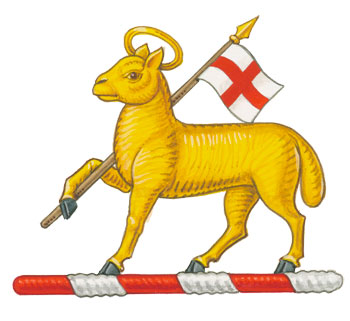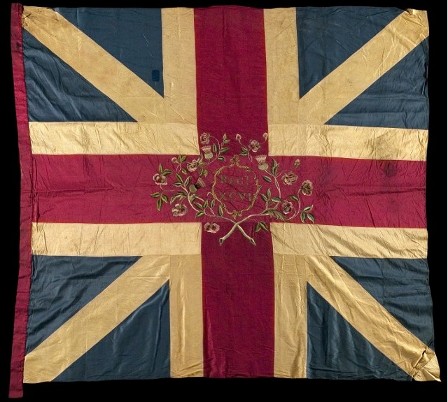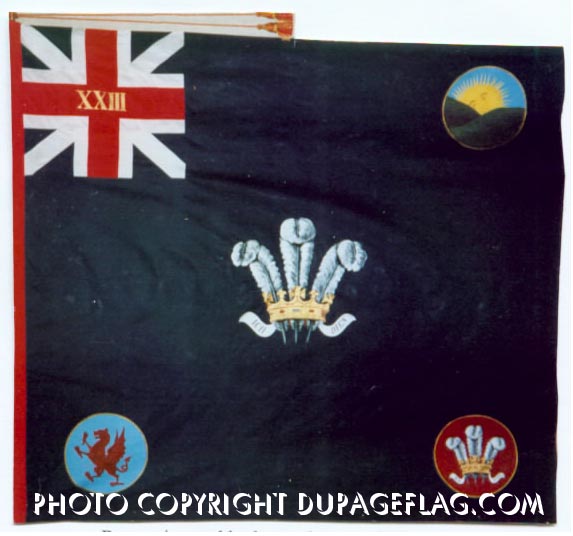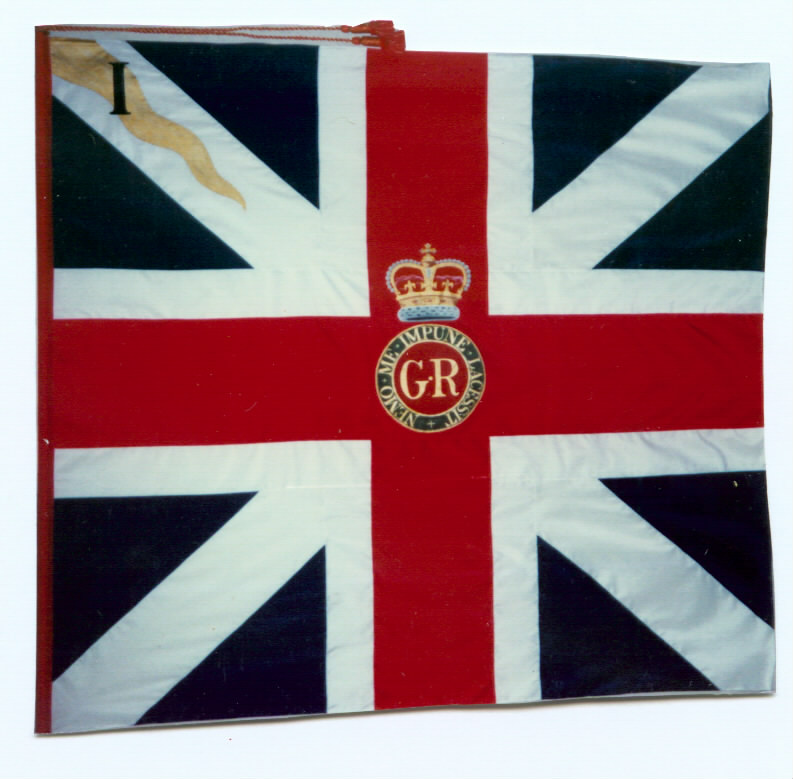I’ve spent my winter break watching Showtime’s The Tudors. During these episodes I’ve noticed many parts of crests, badges, flags, and standards that reminded me of regimental emblems seen in the 18th century army.
The 1768 clothing warrant describes the Devices and Badges of the Royal Regiments, and of the Six Old Corps. In this post, I will briefly investigate the stories of each these devices. Wherever possible, I’ve included links to more detailed discussions of these badges.
Devices and Badges of the Royal Regiments, and of the Six Old Corps
Royal (1st)
In the center of their colours, the King’s cypher within the circle of St.Andrew, and crown over it. In the three corners of the second colour, the thistle and crown. The distinction of the colours of the second battalion, is a flaming ray of gold descending from the upper corner of each colour towards the center.
Queen’s (2nd)
In the center of each colour, the Queen’s cypher on a red ground, within the garter, and crown over it. In the three corners of the second colour,the lamb, being the ancient badge of the regiment.
Buffs (3rd)
In the center of their colours, the dragon, being their ancient badge; and the rose and crown in the three corners of their second colour.
King’s Own Royal Regiment (4th)
In the center of their colours, the King’s cypher on a red ground within the garter, and crown over it. In the three corners of their second colour, the lion of England, being their ancient badge.
5th
In the center of their colours, St. George killing the dragon, being their ancient badge; and in the three corners of their second colour, the rose and crown.
6th
In the center of their colours, the antelope, being their ancient badge; and in the three corners of their second colour, the rose and crown.
Royal Fusileers (7th)
In the center of their colours, the rose within the garter, and the crown over it. The white horse in the corners of the second colour.
King’s (8th)
In the center of their colours, the white horse on a red ground within the garter, and crown over it. In the three corners of the second colour, the King’s cypher and crown.
Royal Irish (18th)
In the center of their colours, the harp in a blue field, and the crown over it; and in the three corners of their second colour, the lion of Nassau, King William the Third’s arms.
North British Fusileers (21st)
In the center of their colours, the thisle within the circle of St. Andrew, and crown over it; and in the three corners of the second colour, the King’s cypher and crown.
Royal Welch Fusileers (23rd)
In the center of their colours, the device of the Prince of Wales, viz., Three feathers issueing out of the Prince’s coronet. In the three corners of the second colour, the badges of Edward the Black Prince, viz. rising sun, red dragon, and the three feathers in the coronet. Motto, “Ich dien.”
Inniskilling (27th)
Allowed to wear, in the center of their colours, a castle with three turrets; St. George’s colours flying, in a blue field; and the name Inniskilling over it.
Invalids (41st)
In the center of their colours, the rose and thistle on a red ground, within the garter, and crown over it. In the three corners of their second colour the King’s cypher and crown.
Royal Highlanders (42nd)
In the center of their colours, the King’s cypher within the garter, and crown over it. Under it, St. Andrew, with the motto, Nemo me impune lacessit. In the three corners of the second colour, the King’s cypher and crown.
Royal Americans (60th)
In the center of their colours, the King’s cypher within the garter, and crown over it. In the three corners of the second colour, the King’s cypher and crown. The colours of the second battalion to be distinguished by a flaming ray of gold, descending from the upper corner of each colour, towards the center.
Elements of Heraldry Used in Regimental Colours
The King’s Cypher

Cypher of King George III, with the Crown
The King’s cypher is a form of monogram of the sovereign’s first name, followed by “R” (for rex or regina). Often, the cypher is shown with the crown surmounted.
In the case of the late 18th century, the King’s Cypher was a script “GR”. King George III, pictured to the right, had a different script than George II. Today, Elizabeth (below) has a cypher in the same manner.

ER Cypher
The Queen’s Cypher
2nd (Queen’s)
The Queen’s Cypher, described in the description of the badge for the 2nd (Queen’s) Regiment, was the cypher of a specific Queen, not the current Queen.
It was comprised of the letters CaRa (CArolina ReginA), Catherine of Braganza – the queen of Charles II, from the time of the regiment’s formation as the Tangier regiment.
The Crown
The Image of the crown in regimental colours is known as “St Edward’s Crown“, and its image is used in coats of arms, badges, and various other insignia throughout the Commonwealth even to this day.
Dating back to St Edward the Confessor’s coronation in 1065, the Crown was destroyed along with the rest of the Crown Jewels during the English Civil War, and recreated in 1661 for the cornonation of Charles II.
The Garter
2nd (Queen’s), 4th (King’s Own), 7th (Royal Fusileers), 8th (Kings), 41st (Invalids), 42nd (Royal Highlanders), 60th (Royal Americans)
The garter referred to in the description of the regimentals badges is the garter of “The Most Noble Order of the Garter”, an English order of chivalry.

The Order of the Garter
The origins of the order have roots in this anectdote: at a court ball, the Countess of Salisbury lost one of her garters. It is said that when bending down and picking it up – the lady blushing and those present laughing, King Edward tied the garter around his own leg and said, “Honi soit qui mal y pense, I shall turn it into the most honoured garter ever worn”. ‘Honi soit qui mal y pense’ translates as ‘Shame on whomever thinks this shameful.’
This Order was founded in 1348 by King Edward III as a noble fraternity (or Chapter) consisting of the King, the Prince of Wales and 24 Knights Companion.
For further information on the Order of the Garter, visit Wikipedia – Order of the Garter.
St. Andrew
42nd (Royal Highlanders)

St Andrew and the Cross
The description for the device of the 42nd mentions “St. Andrew, with the motto ‘Nemo me impune lacesset'”. St. Andrew is significant due to his being the patron Saint of Scotland, the national flag of Scotland bearing his name, and a representation of his cross.
The oval-shaped seal on the 42nd’s colors that contains St. Andrew and his cross appears to be from the Most Ancient and Most Noble Order of the Thistle, a Scottish order of chivalry; probably the Investment Badge of the Order, described as follows:
The Investment Badge is of plain gold, oval in shape with, in the centre, the figure of St Andrew holding the Cross of St Andrew before him, and bearing the motto [Nemo me impune lacesset] on the surrounding band.
The Thistle

Scottish Thistle and Crown
1st (Royal), 21st (Royal North-British Fusiliers), 41st (Invalids)
The thistle is the floral badge of Scotland. Even today, it is used as a symbol to represent Scotland, appears on coins, etc. For more about the thistle, read on.
The Thistle also appears with St Andrew in the Order of the Thistle.
The Rose

The Tudor Rose
3rd (Buffs), 5th, 6th, 7th (Royal Fusileers), 41st (Invalids)
The Tudor rose, the symbol of the house of Tudor. The Rose is a combination of the White Rose of York and the Red Rose of Lancaster, first created by the Tudors at the end of the War of the Roses.

Rose, slipped and Crowned
Even today, a variant of the rose, “slipped and crowned” is an official Royal badge used throughout England, and can be seen on paintings of sovereigns, on coins, uniforms of Yeoman Warders, and the coat of arms of the UK.
The White Horse
7th (Royal Fusileers), 8th (King’s)
The Historical Record of the 8th or the King’s Regiment of Foot describes the White Horse of Hanover as dating to 1123, when the black horse of the Saxon King Wittekend was changed to white to signify his conversion to Christianity by Charlemagne.
The house of Hanover ascended to the English throne with George I in 1714, and remained there through Victoria in 1901. In heraldry, the horse appears in several positions, but according to the Queen’s Own Hussars, when used on colors, it is often pictured with the forelegs up in a galloping position.
The white horse also appears in colors of regiments from Hanover itself.
The Antelope
6th

The Antelope
The antelope, “gorged and crowned” appears in the badges of Henry V, and with an “ordinary collar and chain” in those of Henry VI.
Regimental tradition of the 6th attributes it’s use by the 6th to a Moorish banner taken by the regiment at Saragosa in 1707, but notes that this tradition is not substantiated.
The Dragon

The Dragon
3rd (Buffs)
The Dragon is a symbol of Wales.
The Buffs were awarded the Dragon passant as a regimental badge in 1707, while serving in Marlborough’s army in Flanders.
The Historical Record of the 3rd Regiment of Foot indicates that the Dragon stems from the regiment’s origin in the reign of Elizabeth, whose house (Tudors) used the dragon supporting the royal arms.
The Buffs’ dragon is green, allegedly in honor of the regiment’s old green colors.
The Lion of England

Lion of England
4th (King’s Own)
The Historical Record of the 4th or King’s Own traces the Lion and the 4th to William III – either due to it being the first to join him at Torbay in 1688, or from its dedicated service to him, his government, and to the protestant cause.
The Lion of England is a lion passant guardant. The Lion passant guardant is an attitude that indicates that it walks toward the viewer’s left, with the right forepaw raised and all others on the ground.
The lion appears in many other positions in other European arms, such as the Scottish Rampant Lion, and the Royal Banner of England.
St George and the Dragon
5th

Colors of the 5th Regiment of Foot
St George and the Dragon dates back to a 16th century collection of stories, The Golden Legend.
In this story, St George – the patron saint of England – kills a dragon terrorizing the people of Silene in return for their conversion to Christianity. This motif is a common subject of many medieval works of art.
The Historical Record of the 5th Regiment of Foot notes that there is a regimental tradition that St George and the Dragon was conferred for gallant conduct during “the German war” or the Spanish succession. It suspects, though, that when the regiment was given to Col. John Fenwick in 1675, the badge was added as the regiment was made English.
The Harp

Irish Harp
18th (Royal Irish)
The Harp has been a symbol of arms for Ireland since the late 13th Century, and officially recognized as the symbol for Ireland by Henry VIII. Since the Union of the Crowns in 1603, the harp appeared in the Royal Coat of Arms, and today is used also by the Republic of Ireland and all sorts of Irish products.
William III granted to the 18th the title of “Royal Irish”, and the right to wear the Crown over the harp in 1695, as a reward for their bravery at the siege of Namur in the 9 Years War.
The Lion of Nassau

Lion of Nassau
18th (Royal Irish)
The Lion of Nassau is one of the arms of King William III of England, who was born of the Dutch house of Orange, which still bears this badge today. Like the Crown and Harp, William III awarded the badge to the newly dubbed Royal Irish in 1695 near Namur during the the 9 Years War.
Behind the lion are yellow billets.
This is another of the many forms of lions used in heraldry, as described above with the Lion of England.
Three Feathers and Coronet

Badge of the Prince of Wales
23rd (Royal Welch Fusiliers)
The Prince of Wales’ feathers date to Edward, the Black Prince, in the mid-14th century. The badge is described as three ostrich feathers argent in a coronet., with the motto “Ich Dien”.
The motto, “Ich Dien”, is German for “I serve”.
The story of how Edward took the badge is unclear – one story suggests it was taken from John I of Bohemia at the Battle of Crécy in 1346. Another, much less romantically, suggests that the arms came from either Edward’s father or mother.
The badge appears in many Welsh regimental symbols, coins, and even the Welsh rugby team.
Rising Sun
23rd (Royal Welch Fusiliers)
The Royal Welch Fusileers in America describe the Rising Sun as another device of Prince Edward, the Black Prince.
Red Dragon
23rd (Royal Welch Fusiliers)
The red dragon is a symbol of both the country of Wales and the Prince of Wales himself. In the colors of the 23rd, it is in the attitude rampant, rather than the passant position in the colors of the 3rd.
The Castle with Three Turrets
27th (Inniskilling)

Inniskilling Colors
In 1751, George II awarded the Inniskillings the right to bear on its colors the Castle with 3 turrets, with the flag of St George flying over it.
This same device, commemorating the defense of Inniskilling, is worn by the 6th (Inniskilling) Dragoons, which were formed in Ireland at the same time for the Williamite War.
Circle of St Andrew
1st (Royals), 21st (Royal North-British Fusileers), 42nd (Royal Highlanders)
The Circle of St Andrew is a blue circle with the words “Nemo me Impune Lacesset”. For the Royals and 21st, inside the circle is the king’s cypher. The 42nd, as described above, has a represtation of St. Andrew himself, holding the cross, inside the circle.
The Lamb

The Lamb
2nd (Queen’s)
The 2nd was formed as the Tangiers regiment, and was dubbed the “Queen’s” in honor of Catherine, whose dowry to Charles II included Tangier. The lamb is a representation of Christ, and was thought to be a symbol of Catherine’s family.
The Queen’s Royal Surreys has a set of excellent histories of the use of the lamb in the 2nd and its successor regiments.
Regiments of Foot Guards
The Regiments of Foot Guards have many colors – each company having its own colors with their own heraldry. Many of the companies use the same elements found in these regiments of foot, in addition to others.
Visit Ron Aylor’s site about drums and colors for more information about the Guards.
Further Reading

Original Color of the 9th of Foot
Dupage Military Flags has an excellent history on British Regimental colors of 1747 through 1815.
It includes details on these flags, such as the dimensions of each of the St. George’s and St. Andrew’s crosses on the Union, and details of the wreath used on non-Royal or Old Corps regiments, such as the example of the 9th, pictured to the right.
International Heraldry describes in great detail elements of heraldry. Interested in the difference between dexter and sinister? Is that lion passant, statant, or regardant? This is the site for you.




